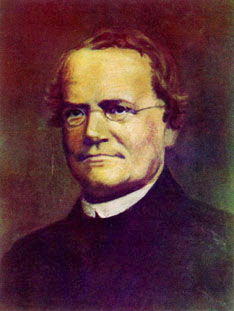Library displays rare Mendeliana at University Mendel Medal Awards
 Anyone associated with Villanova University knows the special status that 19th century Augustinian friar and scientist Gregor Mendel holds on our campus. Most of us have either walked the shiny corridors of Mendel Science Center, relaxed or eaten a hoagie on Mendel Field during first-year orientation or admired the seven foot bronze statue of the “father of modern genetics” that stands behind the Library. Most notably, the University awards the Mendel Medal each year to outstanding contemporary scientists in recognition of their scientific accomplishments and religious convictions.
Anyone associated with Villanova University knows the special status that 19th century Augustinian friar and scientist Gregor Mendel holds on our campus. Most of us have either walked the shiny corridors of Mendel Science Center, relaxed or eaten a hoagie on Mendel Field during first-year orientation or admired the seven foot bronze statue of the “father of modern genetics” that stands behind the Library. Most notably, the University awards the Mendel Medal each year to outstanding contemporary scientists in recognition of their scientific accomplishments and religious convictions.
This year, Villanova’s Mendel Medal recognizes Sylvester “Jim” Gates, PhD, for his groundbreaking work in supersymmetry, supergravity and string theory, as well as for his advocacy for science and science education. Dr. Gates visited Villanova on Nov. 15 as part of a two-day event culminating in a dinner and lecture by Gates in the Connelly Center. As in years past, the Library played a special role in welcoming the esteemed guest to the event by providing display support and rare Mendeliana for all attendees to view during the celebration.
According to Michael Foight, Special Collections and Digital Library coordinator, the items chosen for display were two volumes that represented two of Mendel’s first attempts to explain plant hybridization, which are the basis of modern genetics.
The first of the items is
Foight explains the volume’s historical significance. Gregor Mendel’s experiments with hybridization of pea plants were conducted in the garden at the Augustinian Monastery in Brünn, Austria. Mendel reported these experiments in two lectures, which he read before the Natural Sciences Society of Brünn on Feb. 8 and March 8, 1865. The manuscript was published in the Society’s Proceedings in 1866. An English translation, “Experiments in Plant Hybridisation”, was first published in the Journal of the Royal Horticultural Society, London, 26, 1901, p.1-32.
The second volume,
is Mendel’s paper on the results of his experiments with hawkweed hybrids as read to the members of the Natural Sciences Society in Brünn on June 9, 1869, and published in the Society’s 1869 Proceedings. An English translation, “On Hieracium-Hybrids Obtained by Artificial Fertilisation,” was first published in William Bateson’s Mendel’s Principles of Heredity,” Cambridge, 1902.
Both volumes were presented to Villanova University by the Augustinians of the Province of Saint Thomas of Villanova on January 23, 1999, and have since been displayed regularly at the Mendel Medal event. Lorraine McCorkle, graphic designer for University Communications, prepares the Mendeliana for display each year.
Dig Deeper: If you knew SUSY …
While a primer or even a rudimentary understanding of supersymmetry—aka “SUSY,” the field in which Dr. Gates excels—may be beyond the scope of this article, our Science Librarian Alfred Fry was able to locate a fascinating lineup of videos featuring Dr. Gates, as well as several other links discussing quantum field theory.
Like all our librarians, Fry is available to patrons as a gateway to further resources and help is as close as a click away.
Supersymmetry From CERN: Supersymmetry predicts a partner particle for each particle in the Standard Model, to help explain why particles have mass.
What is supersymmetry? In less than 100 seconds, Helen Heath explains why SUSY is so beautiful.
Series of lectures on supersymmetry given by Jim Gates at the African Summer Theory Institute in 2004 and other videos featuring the Mendel Medal recipient’s work available on YouTube.
Article by Joanne Quinn, team leader for Communication and Service Promotion.
Links prepared by Alfred Fry, Science & Engineering Librarian
Our new Dig Deeper series features links to Falvey Memorial Library resources curated and provided by a librarian specializing in the subject, to allow you to enhance your knowledge and enjoyment of seasonal occasions and events held here at the Library. Don’t hesitate to ‘ask us!’ if you’d like to take the excavation even further. And visit our Events listings for more exciting upcoming speakers, lectures and workshops!
0 Comments »
No comments yet.
RSS feed for comments on this post. TrackBack URI